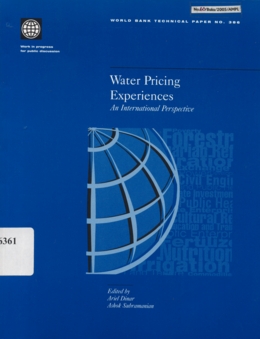Kategori Digilib
Water Pricing Experiences: An International Perspective (World Bank Technical Paper No.386)

Ariel Dinar & Ashok Subramanian (Ed)
USA, The World Bank, October 1997, viii + 165 hal
Th. 1997
338. 4 336361 WOR w
paper, water supply
Perpustakaan AMPL
1.141 kali
Water pricing is an important way of improving water allocation and encouraging user to conseve scace water resouces. Price witch accuarately reflecs waters economic, or scarcity value give information to users, witch they use to make choices regarding water consumtion and use. This water pricing can effect water use efficiency, at both the individual and social level. In practice water pricing schemes may be designed to meet many objectives: policymakers may wish ti discriminate among diferent categories of users or use water charges ti raise revenues for general purposes. Because different levels of decisionmakers may interpret such pricing policies differently, this can lead to undesirable outcomes and, sometimes, to disputes.
This work present water pricing experiences across 22 countries in various sectors and over time. Country case strudies are presented in a structured form allowing easy comparison of result. The information shows that countries have different reasons for charging for water, including cost recovery, redistribution of income, improvement of water allocation, and water conservation. Pricing schemes often comprise both fixed and varible components. Fixed prices vary greatly across countries, reflecting countries various objectives in charging for water. However, volumetric charge for urban and agricultural water are relatively similar across countries. But per meter charges for industrial water vary more widely across countries, reflecting the different use of subsidies and the inclusion taxes that vary by industry.
For urban and agriculturul water, all developing countries, and some developed countries, set charges on the basis of averege rather than marginal cost of supply. Countries do not generally adjust charges by region even though the costs of supplying water may vary greatly across regions. Agricultureal water users generaly pay something for the operations and maintenance cost of irrigation systems, ranging between 20 - 75 percent of total cost. Few countries attempt to recover capital costs from user.
